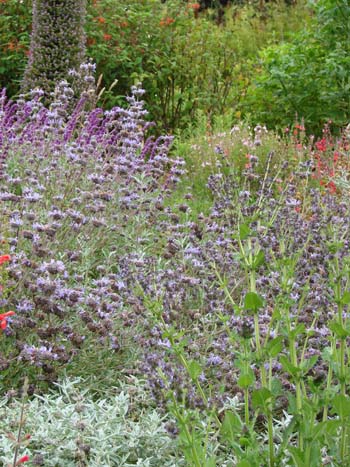July in the Salvia Garden

Ah, July! Depending on where you live, the temperatures may be pleasantly warm or stunningly hot. It's a time of lush plant growth in Salvia gardens, attracting the buzzing and fluttering of pollinators.
Honeybees and wild bees, butterflies, hoverflies and hummingbirds are all about, busily consuming nectar and pollen. Aside from weeding and taking breaks to watch the small wildlife action, there are many tasks to attend to in the Salvia garden during July.
One Caveat Plus a To-Do List
Before we discuss things to do in the Salvia garden during July, here's a warning about one thing to avoid this month -- transplanting established sages. At this time of year, transplants suffer from heat, wind and intense sun, which dry their large root systems too quickly.
Now, on to the Flowers by the Sea honey-do list. Here are eight things you should do.
1) Battle spider mites without pesticides.
It's hard to believe that spiders so tiny you can barely see them can cause so much damage in the garden. Yet Spider mites, which thrive in dry climates, suck the life out of Salvias and other ornamentals. They are particularly hard on potted plants, because the soilless mix in containers dries out more rapidly than garden soil.
The first sign of spider mites you may notice is silky filaments that glint in the sunlight and stretch from one plant to another. Like tiny Tarzans, spider mites swing between branches and plants on these threads. When you see the filaments, give them a powerful spray of water from your garden hose. Also spray the undersides of leaves, because that's where spider mites lay their eggs. Here's more information about how to control spider mites without pesticides.
2) Provide adequate water.
How much water Salvias need varies from one kind to another. When organizing plantings according to similar cultural needs -- such as amount of sunlight and kind of soil -- consider variations in water consumption. Here's an overview about how to water Salvias.
Remember that all kinds of newly planted Salvias need more frequent watering than ones with well-established root systems, such as perennials you planted last spring. Depending on the heat, some may need a drink twice a day.
3) Fertilize carefully.
Some Salvias love rich soil amended with a balanced fertilizer like you would use in vegetable gardens. Others -- especially drought-resistant types native to semi-arid lands -- prefer less nitrogen. They may need little or no fertilizing but benefit from compost that loosens and aerates soil.
Sages limited to containers need enrichment about once every two to three months as the nutrients in soilless potting mix diminish. Here is some information about selecting potting mix with the right nutrient mix.
4) Mulch to conserve moisture, keep soil cooler and discourage weeds.
Granite gravel is an excellent mulch for Salvias. It provides the mineral nutrients many sages need and doesn't cause the mold problems -- prevalent in bark or wood mulch -- to which sages are susceptible..
Groundcovers -- sometimes called "green mulch" -- are another solution to protecting Salvias from overly dry soil and heat. But it may be best to trim groundcover back from the base of a sage plant if the groundcover causes the crown of the Salvia to be overly damp. After trimming the groundcover, circle the sage's crown with gravel mulch.
5) Deadhead spent blossoms.
Deadheading is the simplest form of pruning. It involves snipping off shriveled flowers to keep the plant looking tidy and to encourage extra bloom. If left in place, the flower heads form seed in a process that directs energy away from root growth and repeat flowering.
6) Give container plants extra shade.
One major benefit of container gardening is that you can move plant pots to more beneficial locations as conditions change. If you notice that potted plants in sunny locations start needing more water than earlier in the season and begin wilting, providing additional shade usually helps.
7) Plant perennials like Autumn Sage.
Many Salvias tolerate summer planting beautifully, and may even bloom come fall. That's the case with Autumn Sage (Salvia greggii) and its close relative Mountain Sage (Salvia microphylla). These American native plants are adaptable to soils and other growing conditions in many parts of the nation. They are favorites in drought-resistant gardens.
Depending on where you live, S. greggii and S. microphylla may bloom from spring through autumn. Their flowers add a rainbow of colors to the landscape.
During hot weather, remember to plant in the cool of morning or evening. Then water new plants regularly -- even ones in dry gardens -- to help their roots get established.
8) Enjoy your garden.
Early in the growing season, gardening takes lots of energy due to the amount of weeding, soil improvement and planting. By July, it's time to kick back a bit, smell the sages, sip cool drinks and throw a garden party.
Questions?
You may have questions about July gardening that we haven't covered. Or you may want to know more about plants in the FBTS online catalog. No problem! Please call or send us a message, and we'll be happy to share what we know.

 Salvia greggii 'Grace Pink'
Salvia greggii 'Grace Pink'  Salvia greggii 'Navajo Purple'
Salvia greggii 'Navajo Purple'  Salvia greggii 'Furman's Red'
Salvia greggii 'Furman's Red'  Salvia greggii 'Cold Hardy Pink'
Salvia greggii 'Cold Hardy Pink'  Salvia greggii 'Orange Yucca Do'
Salvia greggii 'Orange Yucca Do'  Salvia greggii 'Playa Rosa'
Salvia greggii 'Playa Rosa'  Salvia greggii 'Salmon'
Salvia greggii 'Salmon'  Salvia greggii 'Wild Thing'
Salvia greggii 'Wild Thing'
Comments
There are no comments yet.